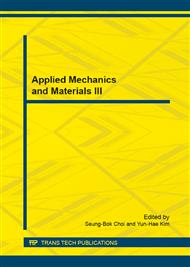[1]
T. Q. Qiu and C. L. Tien. Short-pulse laser heating on metals. International Journal of Heat and Mass Transfer[J], 1992, 35: 719–726.
DOI: 10.1016/0017-9310(92)90131-b
Google Scholar
[2]
T. Q. Qiu and C. L. Tien. Heat transfer mechanisms during short-pulse laser heating of metals. ASME Journal of Heat Transfer[J], 1993, 115: 835–841.
DOI: 10.1115/1.2911377
Google Scholar
[3]
D.Y. Tzou, Macro- to Microscale Heat Transfer: The Lagging Behavior, Taylor & Francis, Washington, DC, (1996).
Google Scholar
[4]
A. A. Joshi, A. Majumdar, Transient ballistic and diffusive phonon heat transport in thin films, Journal of Applied Physics [J], 1993, 74: 31–39.
DOI: 10.1063/1.354111
Google Scholar
[5]
S. S. Ghai, W. T. Kim, M. S. Jhon, A novel heat transfer model and its application to information storage systems, Journal of Applied Physics [J], 2005, 97: 703.
DOI: 10.1063/1.1853896
Google Scholar
[6]
S. Pispati et al. Multiscale thermal device modeling using diffusion in the Boltzmann Transport Equation [J], 2013, 64: 286-303.
Google Scholar
[7]
S. Pisipati et al. A novel alternate approach for multiscale thermal transport using diffusion in the Boltzmann Transport Equation [J], 2011, 54: 3406-3419.
DOI: 10.1016/j.ijheatmasstransfer.2011.03.046
Google Scholar
[8]
R. A. Escobar, B. Smith, C. H. Amon. Lattice Boltzmann modeling of subcontinuum energy transport in crystalline and amorphous microelectronic devices. ASME. J. Heat Transfer [J], 2006, 128: 115-125.
DOI: 10.1115/1.2188951
Google Scholar
[9]
R. A. Escobar, C. H. Amon. Thin film phonon heat conduction by the dispersion lattice Boltzmann method. ASME. J. Heat Transfer [J], 2008, 130: 092402.
DOI: 10.1115/1.2944249
Google Scholar
[10]
D. Y. Tzou, and K. S. Chiu. Temperature-dependent thermal lagging in ultrafast laser heating. International Journal of Heat and Mass Transfer[J], 2001, 44: 1725–1732.
DOI: 10.1016/s0017-9310(00)00215-5
Google Scholar
[11]
D. Y. Tzou, J. K. Chen, and J. E. Beraun. Hot-electron blast induced by ultra short-pulsed lasers in layered media. International Journal of Heat and Mass Transfer[J], 2002, 45: 3369–3382.
DOI: 10.1016/s0017-9310(02)00053-4
Google Scholar


